Wheelchair help guide - What to look for
Hopefully by now you already know if you need a self propelled wheelchair or a transit wheelchair if not please click here to read our help guide on Which type of wheelchair is best for me ?
Once you know the answer to How to pick the right wheelchair you can look at the other things to consider when you are selecting the right model for you.
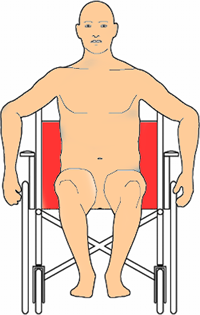 |
FitFitting is probably the most important consideration of a properly functioning wheelchair. The wheelchair should be considered as an extension of your body and for that reason it is essential that you fit the chair snugly. You don’t want the seat width to be too tight but you do not want any wide gaps between you and the side of the seat like the red areas in the diagram. Another big consideration is being able to reach items whether they are down below you towards the floor or above you on a shelf. A good rule of thumb is to make sure that when you are sitting upright on your wheelchair that your fingers can reach the centre of the rear wheels. Another size related consideration is the overall width of the wheelchair. Although accessibility has come a long way, the smaller and more compact the wheelchair is, then the easier it is going to be independent. Nowhere is ever going to be 100% wheelchair friendly but the smaller the chair the easier it is to get around particularly through doorways or in to cubicles. |
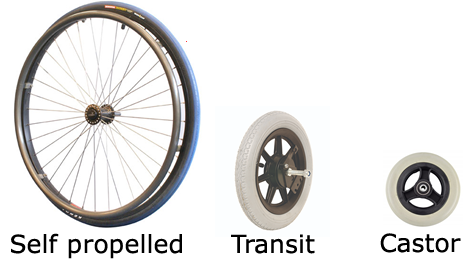 |
Wheel size and typeThis can affect the performance and the look of the wheelchair. Most self propelled wheelchairs come with a 24" rear wheels. The bigger the wheels the faster the chair can be self propelled. Most transit wheelchairs come with a 12" rear wheels. Front castors vary in size but are typically about 7". |
 |
Wheelchair tyresThe main choice here is whether to select a solid PU or puncture proof tyre as seen on the left or an inflated or pneumatic tyre as seen on the right. The main consideration here is reliability versus comfort. A pneumatic tyre set with the right pressure will provide an element of cushioning from the lumps and bumps en route. Whereas a solid PU tyre has very little protection from this but does provide the reassurance of not getting a puncture. Tyre texture can also vary and should be selected to reflect the terrain that you are likely to encounter the most. For indoor use a smooth tyre will be the most efficient as seen on the left. If you are more likely to be out and about then a tyre with some tread such as the one on the right will provide better grip particularly when used in wet conditions. Wider tyres are also better for use on soft ground such as grass. |
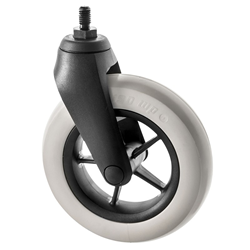 |
Front castorsAgain form and function is the key here. Castors come in all shapes and sizes which affects the way that the wheelchair performs. Smaller castors are less able to cope with bumps like cracks in the pavement and can lead to the wheelchair stopping unnecessarily, where a larger castor would simply ride up over the bumps allowing you a smoother ride. |
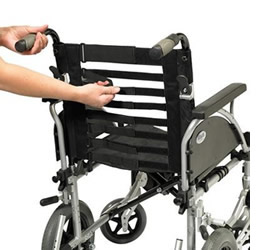 |
Seat backsSeat back style and height will affect the way you use the wheelchair. Most wheelchairs have soft upholstered seat backs that are light in weight and can be folded with ease. The biggest consideration is the height of the seat back as this will govern how much support is provided which promotes proper posture and muscle development. Some wheelchairs allow the tension of the seat back to be adjusted which allows you to control the comfort / support balance. Some seat backs have the ability to fold down. This is an important consideration as it can affect your ability to reach behind you and also the space required when stowing the chair away. A wheelchair with a half folding backrest will require less vertical space for storage. All soft upholstered seat backs will fold vertically allowing the wheelchair to be folded (like a concertina) for storage. |
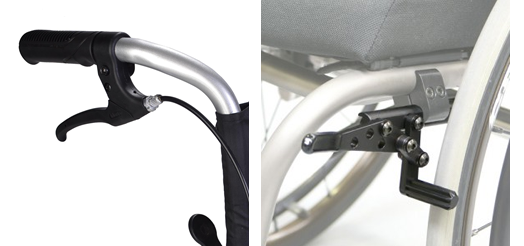 |
Wheelchair brakesThese are a really big consideration as they can help both you the user and the attendant who might be pushing your wheelchair. Brakes come in two forms, those that are operated from the push handles (by the attendant) shown on the left and parking brakes that are within reach of the wheelchair user as shown on the right. Parking brakes are essential to keep the wheelchair stable and stationary when you transfer on and off the wheelchair. |
Wheelchair accessories
Wheelchair accessories come in many forms including cushions, cup holders, elevated leg rests etc. but remember all accessories add extra weight to the wheelchair and can also make it bulkier making it less easy to fit in to the car. One accessory that we do suggest you consider are side guards that are there to prevent items like clothing from coming in to contact with the rotating wheels as this can lead to problems. They also protect your clothes from getting dirty.
All of the above things are suggestions only and ultimately you the user need to decide what works best for you and your lifestyle as these will affect your confidence and independence. Getting the right wheelchair and getting it to work for you is a process that can take some time. We suggest that you try making all manner of adjustments until you find the settings that work the best for you.











